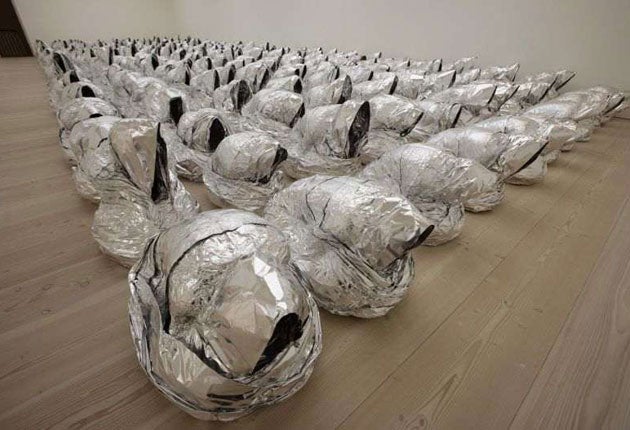Unveiled: New art from the Middle East
Saatchi’s tour of the Middle East

Your support helps us to tell the story
From reproductive rights to climate change to Big Tech, The Independent is on the ground when the story is developing. Whether it's investigating the financials of Elon Musk's pro-Trump PAC or producing our latest documentary, 'The A Word', which shines a light on the American women fighting for reproductive rights, we know how important it is to parse out the facts from the messaging.
At such a critical moment in US history, we need reporters on the ground. Your donation allows us to keep sending journalists to speak to both sides of the story.
The Independent is trusted by Americans across the entire political spectrum. And unlike many other quality news outlets, we choose not to lock Americans out of our reporting and analysis with paywalls. We believe quality journalism should be available to everyone, paid for by those who can afford it.
Your support makes all the difference.What time do you make it? Good lord, it must be time for the second blockbuster show at the new Saatchi Gallery in Chelsea, a truly swish, free-to-enter location. Last time, we had China. This time, there is the unifying element of geographical location once again, but not of political entity. In fact, politics has kept one Middle Eastern country well out of the running. Did any of the selectors mention Israel at any point? And did we all fall about laughing?
But would we in fact know how many distinctively different countries, each with its own native traditions, were represented here if we hadn’t been told there were so many? Not necessarily. This is, again, a show of artists who have been, for the most part, internationalised by the way they have lived their lives. They all know how to manipulate photographic images on the grand scale. They’ve all seen and loved the work of Philip Guston. We go around ticking off the influences, praising some for interesting variants, feeling less excited about others. Some of the artists in the main show live in Europe, and some in America. A number continue to live in the Middle East.
In order to see artists who were more deeply embedded in those native traditions, you have to go right up to the top of the building, to the Philips de Pury Gallery, where there is an excellent exhibition of works by Middle Eastern Modern Masters. Don’t miss this one. Don’t tire too soon. It’s a fairly long journey. These paintings are often much smaller than most of the works downstairs – a degree of modesty, perhaps.
Oddly, the show begins, as we enter the first gallery, in exactly the same way the China show began – why play the same trick twice? – with a sprawling, floor-level installation of a cityscape. Last time, the artist had invited famous buildings from the great cities of the world, often slightly wonkily misrepresented, along to the party. This time, it is Beirut alone that we stare down at, in the form of a low-relief architectural drawing of the entire city, made entirely of rubber. In spite of the fact that Marwan Rechmaoui’s work does demarcate particular neighbourhoods, it feels, given the terrible sufferings of Beirut over the past 30 years, like a surprisingly neutral and underwhelming statement. Of course, we catch the symbolic importance of the material, but the piece itself fails to sing out.
Politics plays a big part in this show, as you’d expect: the maltreatment of human beings, and of women in particular; the destruction of buildings |by war. One of the most eye-catching pieces, filling an entire gallery, is Ghost by Kader Attia. We are getting rather accustomed to artists filling entire galleries with human forms, squeezing in dozens and dozens of them. This time the human forms, all in serried ranks, and all facing in the same direction, are prostrating themselves. One has its face right down to the floor. Each is made from aluminium foil, enveloped and entirely hooded by aluminium foil, which makes them look a little like honorary Middle Eastern members of the Ku Klux Klan. Now peer inside one of those hoods. Nothing there. A yawning emptiness. Only the shape is real.
Yes, it’s pretty affecting, this piece, and one reason for its impact is that there is no simple message. It eludes interpretation. Think of what it might mean, and your first guess is that it is a dangerously courageous attack upon religion. Think a little longer, and the meaning seems to have evolved into the opposite of that first thought. Hmm.
There is much politicking here, but also moments where the past does seem to have impregnated the practice of the present quite hauntingly and quite beautifully. Look, at the delicate, almost precious, paintings on linen by Hayv Kahraman, statuesque figures of women whose seeming innocence is quickly snatched away when you suddenly notice, as if by accident, the sacrificial blood that is being shed. Then there are the strangely grotesque-cum-voluptuous photographs of Ramin Haerizadeh, adapted from theatrical traditions harking back to the Qajar dynasty, in which bearded men smooch and schmooze like pantomime whores in gloriously ridiculous costumes.
To 6 May (020-7823 2363)
Join our commenting forum
Join thought-provoking conversations, follow other Independent readers and see their replies
Comments